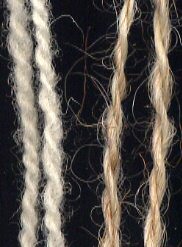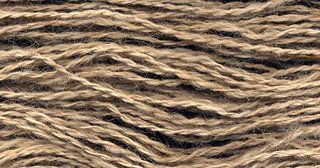I bought the fleece at a SAFF fleece show a couple of years ago. I got it because it was a rare breed and chose this particular fleece for its color (thinking to use a variety of both breed and color in my sweater.) Karakul sheep are predominantly, black; so the light reddish color of this particular fleece is a little unusual for the breed.

This particular fleece was a show fleece and so quite clean. It had virtually no VM nor second cuts. It had been pretty well jumbled up by the time I got it, I presume from being handled by the judges.
Karakul is actually a dual coated breed. The fleece is quite open, so it was easy to separate the inner and outer coats. By firmly holding onto the tip of the lock, I used a dog comb to pull out the softer inner coat from the butt end of the staple.
This bit was taken from the sample I washed:

Karakul is actually a dual coated breed. The fleece is quite open, so it was easy to separate the inner and outer coats. By firmly holding onto the tip of the lock, I used a dog comb to pull out the softer inner coat from the butt end of the staple.
This bit was taken from the sample I washed:

The little pile on the right is of reddish kempy fibers which are the shortest and the prickliest.
For my first sample however, I decided to wash a handful and then blend the two coats with my drum carder. Since it is a pretty coarse fiber, I thought I would spin it with as little twist as possible to make it more suitable for knitting.
I accomplished this by spinning with the worsted method and using the lowest ratio my Ashford Traditional offered. I drafted out about two inches for each treadle, resulting in less twist than I usually put in a knitting yarn.
You can see the difference of the twist angle in these two yarns.

For my first sample however, I decided to wash a handful and then blend the two coats with my drum carder. Since it is a pretty coarse fiber, I thought I would spin it with as little twist as possible to make it more suitable for knitting.
I accomplished this by spinning with the worsted method and using the lowest ratio my Ashford Traditional offered. I drafted out about two inches for each treadle, resulting in less twist than I usually put in a knitting yarn.
You can see the difference of the twist angle in these two yarns.

The one on the right is some Ryeland spun a couple of years ago. It will be used for most of the sweater. On the right is the Karakul I just spun. Both yarns measure 10 wraps per inch.
My finished skein looks like this:

Before I decide to use this skein for the sheep motif of my sweater, I'd like to experiment a bit more. Since I have an entire 3 pound fleece, I have plenty to play with. I'll be curious to see how a few more yarn samples compare with this one. After that I'll choose one to actually use in the sweater.
My finished skein looks like this:

Before I decide to use this skein for the sheep motif of my sweater, I'd like to experiment a bit more. Since I have an entire 3 pound fleece, I have plenty to play with. I'll be curious to see how a few more yarn samples compare with this one. After that I'll choose one to actually use in the sweater.
© 2006 Leigh's Fiber Journal
Related Posts:
Karakul 2
Winter Knitting Project
Rare Breed Sweater Swatches
TA-DAH! Rare Breed Sweater Done!
karakul, I have not seen Karakul for a long time. I spun some up years ago and thought it to coarse, I had no idea they had a dual coat. Always great information thanks
ReplyDeleteWhat an enchanting colour - it really is unusual. It reminds of the colour of highland cattle.
ReplyDeleteThank you for that, Kate! Much nicer than what I was thinking as it reminds me of jute.
ReplyDeleteI love the colour too!
ReplyDeleteAnd thanks for the dog brush tip for getting the coarse hairs seperated from the finer softer ones. I have a bit of quivet that was scraped from a hide and still has all of the long and medium length coarse hairs. I have been SLOWLY picking away at it, but there is only so much picking that one can do in a sitting. Do you have any other suggestions? I would be glad to hear them.